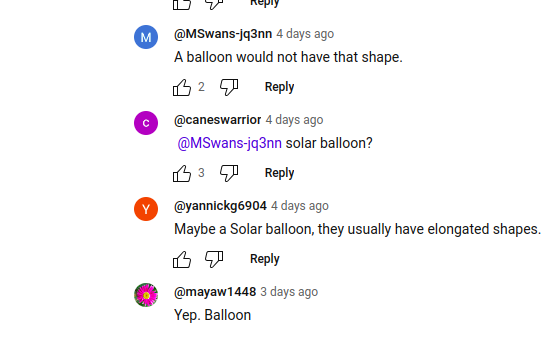Leaderboard
Popular Content
Showing content with the highest reputation since 04/29/24 in Posts
-
My opinion of him went down considerably when I learned he has tried to rubbish philosophy: https://whyevolutionistrue.com/2014/05/20/pigliucci-pwns-neil-degrasse-tyson-smbc-teases-pigliucci/ He doesn't seem to understand that science is both rooted in philosophy and poses philosophical questions. So I suspect he's a bit shallow. I'm sure he knows his science but I would take anything he says about other matters with a pinch of salt.3 points
-
@Moontanman I wonder why you buy so much into 'aliens' and 'government secrecy'. First, on physical grounds, it is extremely, nearly impossible, that aliens visit us. Special Relativity sets a clear limit to travel speed. G-forces, and collisions with dust particles set high limits. Of course, slowly travelling, with generation spaceships cannot be excluded, as von Neumann probes (but then its not aliens visiting us, but their probes, that should be able to navigate autonomously, find out by themselves what is interesting, etc). Simply said, it needs a lot of additional hypothesis that we even do not know are possible. Second, most of the UFO sighting have earthly explanations. Reaching from simple explanations (Venus, Jupiter and Mars), weather phenomena, satellites, (experimental) planes, weather (and solar!) balloons, etc), to sightings that cannot be explained, but even the latter does not mean 'aliens!' 'Unexplained' means unexplained, nothing more. Not very satisfying of course, but it is as it is. Third, UFO sightings tend to come in crazes: one fascinating UFO sighting, and often it is followed suddenly by many more UFO sightings. For me a clear indication, that people are more inclined to 'look up', and then immediately take the most improbable explanation: aliens, or even worse, an alien invasion is imminent. Fourth, for government secrets, there is a pretty simple explanation: when they are doing experiments with 'flying objects' they might be interested in people that do not pay too much attention to anomalous flying objects. This is at least my explanation for Edward Condon's very unscientific approach. Just deny that they exist, declare that all UFO sightings are fully explainable, and all observers will only think 'hey, funny what I see there, but it cannot be UFOs, because they do not exist'. That backfired of course completely, and only contributed to conspiracy theories. Fifth, a whole lot of people just want 'aliens!' to be true. They do not want to falsify (in the Popperian sense of the word) the alien hypothesis, they take every unusual sighting as confirmation of their belief, even if there are simple explanations. The solar balloon sighting, and the reactions on Youtube are great examples. The huge majority says 'aliens!, then come many with secret flying things from the Air Force, (or NASA), and then only very few come with trying to find earthly explanations, and veeeery few with the correct explanation. And nobody reacts on these correct explanations. There is no rational discourse at all. Considering all this, the question is if UFOs are a legitimate research object for science. You maybe surprised, but my answer is 'yes'. But first all these explainable sightings must be filtered out, and there must be tangible proof. And it should be serious researchers, not Loebs, who are the pseudo-scientific variants of alien believers.3 points
-
I lean towards spacetime as a mathematical entity. What has increasing curvature near a massive object? The math. Curved geometry. No sheets, no bowling balls, no stuff. Like going to the bowling alley without equipment and saying, I'm ready, dudes, I brought pi, f=ma, and a couple other maths with me. What breaks down at the singularity? The equations do. It's math being employed to do things that it's hard for math to do. JMAPCO (just my astrophysics-challenged opinion)2 points
-
Home destroyed due to bad management or disaster(s)? propagation?2 points
-
I was going to reply similarly - a Kardashev scale II or III civilization could do more with Von Neuman devices than we could. At that point, a probability analysis shifts from the rigors/cost of crossing interstellar space to how likely is a K2 or above society. An analysis for which data (that we puny humans could access) is lacking. In any case, I agree the probability of a VN seeded galaxy seems much higher than ET biological entities in ships that play peekaboo and have well-stocked proctology clinics. (though given healthcare costs in the States, could anyone complain about being snatched up for a free endoscopy session?)2 points
-
If two rockets each approached the space station at 0.5c, from opposite directions, they would be approaching each other at 0.8c (.5 + .5)/(1 + 0.5*0.5) (Galilean addition would give you c)2 points
-
Just come across this Flashmob video from Lausanne, in the course of revising the bass line in my favourite chorus from Bach's St. John Passion: The cellist plays part of one of Bach's Cello Suites and ends on a (baroque pitch) G, from which the basses can get the C they need to start the fugue. The conductor pretends to be a waiter delivering beer to the next table, until the moment arrives. They sing it very well, especially given the acoustics of a busy restaurant. Pretty cool, I thought. This chorus is in 3/4, with real JSB swing, syncopation and drive. Fantastic music.2 points
-
I especially like this last bit of discussion. Great summary by @Eise. Nice response by @Moontanman. @TheVatclarifying the subtleties. These discussions often seem to fall apart I believe due to the reputation of many alien advocates, and the lack of hard evidence. Given all the crazies out there and the lack of meat available for scientists to sink their teeth into, it is hard to have a good discussion around what we do know, what we can investigate, and whether it is worth the effort. While Moon is more interested in the possibilities than the average person on this site, I have never seen him dip his toes into the crazies waters. While I don't participate in this topic much, I do enjoy following it.2 points
-
I took @Eise to mean that the technological requirements and durations of trips make them low probability events. I am not sure if nearly impossible is how I would put that, though. Where sentient life develops specific goals (of which we humans have a very limited sample), low probability events can be pushed towards much higher frequency. For me, the scientific view is to remain neutral on what other sentient creatures may want or seek. Was there another thread where we talked about the photo plates from 1952? I have to go AFK atm, but maybe worth linking to.2 points
-
Following on from @Moontanman's thread on a new nitrogen-fixing organelle, I started wondering how biological nitrogen fixation first arose at the dawn of life. I found the linked paper, which I thought very interesting on the subject: https://www.sciencedirect.com/science/article/pii/S0966842X23000914 The writers focus on the metal atoms (or metal/sulphide complexes) which are at the heart of nitrogenases, which can bind nitrogen, lower the strength of the triple bond and progressively add H+ and electrons to form eventually 2 molecules of ammonia. There are 3 variants of nitrogenase, one using just Fe, one using Fe and Mo (molybdenum) and one using Fe and V (vanadium). I was surprised to see these 2 transition metals have such a biologically important role, but there you go. It seems there is evidence the first nitrogenase appeared in the Archaean, before the Great Oxygenation Event (i.e. global-scale photosynthesis), which I suppose is not a surprise, seeing as a lot of life would be needed to geo-engineer the planet, and that would require a lot of fixed nitrogen. They suggest that, before the GOE, there would have been a lot of Fe²⁺ in the oceans, whereas under oxidising conditions this would go to Fe³⁺, the salts of which tend to precipitate from aqueous solution, so would be less bio-available. So a system incorporating Fe is not hard to explain. Curiously, though, phylogenetic analysis suggests that the version incorporating Mo as well as Fe was the first to appear, even though the concentration of Mo in the early ocean was apparently very low. That version has better kinetics, which may have favoured it, but it still leaves open the issue of where the Mo came from. They speculate that there may have been higher local concentrations in the zones where the first nitrogenase arose, perhaps in hydrothermal vents. But this is very much open-ended and needs further research. By the way I found the chemistry of these nitrogenases really interesting. There seems to be some very unusual chemistry, involving bridged hydrides to supply the extra electrons needed for the reduction. But that's another subject. It seems the evidence is that nitrogenases are an "evolutionary singularity", meaning this little family of 3 closely related variants, using the 3 metal combinations mentioned, seems to have evolved once only in the whole history of life on Earth. But absolutely vital to the whole enterprise of course.2 points
-
Your right I didn't bother responding to your logic. As I stated I lost interest. Particularly when you have statements such as information travelling faster than c that you cannot back up with any real physics or mathematics. This includes your holonomic toroid allowing a faster than c wave. This runs counter to well known and understood physics. So any logic based on this is meaningless if you cannot show how that's even possible under mathematics using known physics. Another example is some mysterious toroid travelling at c. It must be something massless to do that. However you can't describe it beyond your verbal claims. I also have no interest in downloading a paper from an outside source when the rules requires that material to presented here.. Who knows you might catch my interest once you start applying some real physics or mathematics. Rather than nothing more substantial than your logic2 points
-
Among those, Fe plays an outsized role for tons of redox reactions. But some of the rarer ones (including Mo and Va) have been utilized in rather critical enzymes and have not been replaced by more common metals, which in itself is interesting. If you are interested, there are whole fields on metalloenzymes, with recent approaches how various moieties in these large enzyme complexes might move during the various electron transfer processes. Not entirely my world, but it pops up frequently (and sometimes you get to work with folks on things like these). And also the work with them is annoying, just getting your media and glass ware free of metals is a nightmare.2 points
-
Not quite. The net reaction of photosynthesis are two separate reactions which are not really mechanistically coupled. Specifically, it initiates an electron transfer chain (functionally similar to respiration) in order to pump protons which then chemoosmotically generate ATP. Water functions as electron donor during the water splitting event. I do think that the chemical notation masks a little bit the underlying biology, especially as carbon fixation in some bacteria happens without light, but that is neither here nor there). I probably should add that glycolysis happens in the cytosol, and the pyruvate is then delivered to hydrogenosomes. The reaction in hydrogenosomes is simpler and ATP formation is by substrate level phosphorylation, as mentioned before. Hydrogen is basically formed to re-oxidize ferredoxin, which is needed for the decarboxylation reaction from pyruvate to acetyl-CoA. Not entirely sure if I get it right but it should be something like: Pyruvate + 2 [H+] + Ferredoxin(ox) -> Acetate + H2 + Ferredoxin(red) + CO2 One way to think about this is that respiration (aerobic or anaerobic) is basically using a redox potential to energy generation, rather thinking that a particular compound being fuel or waste. Basically, if you have a nice electron donor and acceptor pair that generate a nice potential, you can use that potential by using to drive an electron transport chain, that also pumps protons out of the cell to generate a proton gradient that is then used to generate ATP. This means that depending on which pair the cell uses, the same compound can be used as donor or acceptor. Hydrogen is used by many bacteria as electron donor but is also released often in fermentation processes (or the reaction above) to essentially balance the redox budget of the cell (and as you can imagine, released hydrogen can be used by other bacteria, creating interesting cycles within bacterial communities).2 points
-
I just read some comments on the video. Seldom had more fun. Here a selection: This woman is a legend, first clear UFO footage in history Finally a clear picture of a ufo instead of the usual dark and blurry images (Eise: yup, therefore it was so easy to recognise) This is the best clearest footage of UFO I have ever seen. US Government: "Relax it's just a weather balloon." (Eise: no, it was't...) Literally the best footage of a “ufo” to date …bravo!! U guys deserve something as a news station SERIOUSLY! probably the best video/picture caught of a UFO ever lol 1. It wasn't fast, the aircraft was, that's why you see it zipping through the video. 2. It's a blade propelled object judging from its inclination, probably a drone. 3. The drone was operated by the government or related agency because even considering how dangerous this was for the airliner, no news about investigation had been announced. Why is everyone so scared to say what it really is?? (Eise: because it would shock your world view) That’s our own government. Stop Do you really think you caught it on your home camera and the government doesn’t know? They have been here for thousands of years. Cylinder Aka cigar shaped crafts are one of the most common UFOs. Legit sighting in my opinion. Great catch.. (Eise: obviously a real expert!) This is one of the best UFO footage in recent decades (Eise: his emoticons, sorry that they became so big...) Etc etc. Naivety, conspiracy theories... There are however a few who notice that it looks to fly fast, but that it could be the speed of the plane. Some examples: The plane flying at 2 to 300 miles per hour, if you look closely, that object could have very well been stationary given the travel direction of the plane if you look at the land while it's flying and how the object seems to fly by at a high speed but could very well be almost sitting still. Black balloon with helium? It’s not moving, you are. (Eise: close, very close...) And the price goes to:2 points
-
Sorry to disappoint, but I recognised it immediately: The speed is the speed of the plane. It was 'a close encounter of the daily kind'. Blow it up in a cool place on a hot day (inside your home or in the shadow), bring it into the sunlight, until it lifts and let it go, and you will never see it again. From this Swiss site. Costs 12 Swiss bucks. What a fuzz about a funny, but physically interesting toy. I once 'launched' one. Ah, there is even a wikipedia article bout it: That was a fast +1, Moontanman. Small correction: blow it up on a cool but sunny day. Obviously there also much bigger ones...2 points
-
I think this is where a misunderstanding arose, as the discussion shifted away somewhat from the OP. I take your and @toucana point as to where the thread started, so I didn't make clear that I thought the thread had moved a bit and was trying to follow that. My point goes to the substantial difference (especially re the fate of Earth's supporting ecosystems) between any nuclear exchange and all the other historical forms of massive death you described. I won't rehash that, but anyone who wants to review previous posts is welcome to. I agree there is a legitimate moment of self-defense in a war, but I tried (and failed) to make some points as to how a nuclear "defense" can ultimately kill so many people who are not attacking. Therein lies the problem of proportionality, as well as Geneva issues, plus the migration of radionuclides and weather effects to friendly nations, also addressed by me and others. Again, I didn't communicate well that I see this as more than just a form of the Trolley Problem, because of the unique implications of annihilating an entire (or several entire) cities (and what that opens up, in terms of a larger war). We don't have to explore them here. I gave it a shot, but will step aside so others can resume with the original question.2 points
-
How do you know it was me who negged it? Neg one of mine, I don't really care about that. It's in the top ten long-term threats. Short term yeah sure, not a big threat. I'm talking about this issue because that's what this thread is about. I can go just as long debating other issues where they are relavent and threats to mortality as they are brought up. Just don't expect the same level of substantive answers in this discussion to show up in a discussion about cutting hot dogs laterally into long strips instead of small perfectly air pip sized cylinders to avoid choking hazards for young children. It's not the same. If I just randomly spout up about other threats to my loved ones unrelated to warfare or nuckear equatable disasters, then I'm off topic breaking the rules. Why does this need repeatedly explained Dim? If you don't want to take part in the discussion or think it is pointless, then why chime in at all? This is a forum, whining about people talking about what is brought up, where it is brought up, in line with rules about being on topic, that's the real conversation not worth having that is a waste of your time and mine.1 point
-
Nothing. The 4D-spacetime curvature becomes infinite. So what? The intrinsic curvature at the vertex of a 2D-cone is infinite, too.1 point
-
It isn't reasonable, it's just one extra low-P thing to cross off the list. And I meant more in ongoing investigations. One can't inspect equipment or give post-flight physicals to people in the 1940s. I just meant investigators should strive to rule out even unlikely scenarios so that the investigation data isn't tainted later because someone says oh they didn't eliminate that. E.g. if something caused a short in some industrial equipment, I would think a cat crawling in there was improbable but I'd still check for burned fur or whatever.1 point
-
Agreed on that, there are cases where the witness really didn't want the attention. One would tend to give those witnesses greater credibility. Doesn't mean a mistaken identity wasn't involved etc etc. I tend to have more respect for the cases where it's clear the motivation has nothing to do than generate monetary gain or attention seeking.1 point
-
I personally don't base my opinion of any physicist by how popular they are in the media etc. Yes they tend to excel at taking complex topics and simplifying for the public which is very useful and beneficial. It generates interest to help generate new students as well as enhances interest for research etc. So that's never a bad thing. However I tend to focus on their research papers etc. Neil DeGrasse papers aren't bad but someone like Sean Carroll has a wider range of recommended literature. However that's just me1 point
-
It's best to regard spacetime as simply the arena where the SM model of particles/fields reside. It really is simply a volume that uses the Interval (ct) to give time dimensionality of a length. Spacetime curvature under this describes the particle paths and the easiest way to understand this is to use parallel transport. (The equations of the EFE also uses parallel transport) If spacetime is flat two parallel beams of light will remain parallel. If you have positve curvature those beams will converge. If you have negative curvature they will diverge. For gravity use the same manner. Draw two lines at some distance apart and connect them to the CoM. You will notice those lines converge as you approach the centre of mass. Another useful tool to understand why particles follow different paths is to realize that all particle motion obeys the principle of least action. (This includes Feymann integrals as well as spacetime geodesics). Terms such as fabric etc gives false impressions of spacetime being some material or substance. It really is simply a metric that describes a volume and spacetime paths (null geodesics for massless particles such as photons). What affects the paths is all matter and force fields of the SM model. The coupling constants collectively give rise to the mass terms (mass is resistance to inertia change). They also have strange stars that suggest with certain neutron stars all quarks become strange quarks. Some models really stretch the imagination but surprisingly enough do have enough viability to warrant research. As for myself I study some of these as they often include unique ways to mathematically describe fields and states that I find useful for model developments. They also have papers suggesting a dark sector of a wide range of particles such as dark photons etc. Yeah I don't agree with the theory myself I ran across it a few years back.1 point
-
Free entertainment. Even leaves one with a fuzzy feeling that they learned something.1 point
-
My thoughts are, he's a good teacher at a certain level, IOW he's read at least two pages past his student's, but doesn't understand the question of puberty... I'm with @Eise +1, just late to the conversation...1 point
-
All All good Found a decent article for the OP though older describes the proton-neutron ratios of exchange in our atmosphere due to cosmic ray interaction. " At sea level, neutrons contribute about 10 percent of the total radiation exposure to man from cosmic rays (ref. 1). Neutrons reaching the Earth's surface are principally created in the Earth's atmosphere by the interaction of the primary cosmic rays with oxygen and nitrogen nuclei at high altitudes and in the subsequent development of a hadronic cascade down through the atmosphere. (Relatively few neutrons are present in the primary galactic cosmic radiation or solar radiation reaching the Earth because their radioactive half-life is approximately 12 min.) Two nuclear reactions are important in the production of cosmic-ray neutrons: direct inelastic reactions producing "knock-on" neutrons, with energies from about 1 MeV to well in excess of 1 GeV, and evaporation " https://ntrs.nasa.gov/api/citations/19760008919/downloads/19760008919.pdf1 point
-
Roadside Picnic - Wikipedia1 point
-
The moon near the horizon seems bigger; this is known as the moon illusion. There is some debate as to the exact cause - there are several possible contributing factors. One is the difficulty in judging distance to things on the horizon - an object in the sky can be further away than those on the ground and still be visible. https://en.m.wikipedia.org/wiki/Moon_illusion1 point
-
Capitalism isn’t necessarily to blame, at least not as much as our failure to include negative externalities into the costs paid by producers and consumers of goods and services. Manufacturer doesn’t get fined for poisoning the water. Consumer doesn’t get taxed for continuing to buy goods from that manufacturer. The cycle of water poisoning persists while healthcare needs skyrocket and economic burdens get shifted (shafted?) to everyone downstream who weren’t ever even involved in the transaction. Carbon taxes were an attempt to address this and it want capitalism that made it fail. It was politics and short term self-interest among plutocrats.1 point
-
The Von Neuman hypothesis strikes me as the most neutral in its assumptions: for whatever reason, advanced civs may send out self-replicating units in the millions (and thence to billions via replication) and they just blanket all star systems in the spectral range most hospitable to life. Or not. Other filters are possible. We can't say what cost/benefit ratio is determined by a K2-plus civilization, or if anthropological fascination has anything to do with it, or what ethos they may have about contact, or if carbon-based life is seen as interesting...or just an old-fashioned and disgusting fetish that preceded the Glorious Uploading. Or quaint, and as @Moontanman mentioned, a niche hobby for some tiny fraction that studies emerging sentience. If aliens were machine intelligences, they could have some form of immortality that would open up motivations we can't conceive of, where shutting down for a ten thousand year journey would be routine. Or a nice field trip for fourth graders.1 point
-
Again, I do not assert UAP are aliens, they are unidentified, aliens is just one remote possibility, time travelers have been suggested as a possible explanation but I have my doubts about time travel as I am sure most people do. They could be visitors from another plane of existence, or as Jacques Vallée has suggested, quite seriously, that the UFO phenomena is connected with things like fairies, gnomes, and other supposed supernatural creatures from lore. The most obvious thing here is that UAP are just misidentification of known or unknown natural objects but the best data we have doesn't support that premise in many cases... it is these outliers that concern me. And no, "It could have been a picture of a hubcap someone threw", is not a viable explanation. As for alien motivations... you make a good point if you are talking about a civilization that is only a few thousand years since it lived in caves. A civilization that has existed for millions of years might have more long-term goals and data can be transmitted at the speed of light. Trying to guess the motivations of aliens is not a winning gambit.1 point
-
No, spectral lines have finite width for a variety of perfectly good reasons. (Finite line width means there is a range of absorbing or emitting frequencies of course.) These include the Doppler effect, from motion of the emitters relative to absorbers, and uncertainty broadening, due to finite lifetime of the excited state leading to uncertainty in its energy, by Heisenberg's Uncertainty Relations. In gases, this can be a function of pressure, cf. "pressure broadening", since collisions may shorten lifetimes of excited states and also alter their energy, due to transient proximity of second atoms, thereby disturbing the potential experienced by the electrons. And for matter in condensed states, atomic lines tend to get broadened into bands anyway, due to the overlay of vibrational and/or rotational fine structure. If you read up a bit about spectroscopy, there is quite a bit to it besides simple line emission and absorption.1 point
-
Great stuff. Bach innovated in so many ways, counterpoint, modulation, four part harmony, use of dissonant chords, even in stepping back to Dorian mode and others. Always a fan. And provider of Bach jokes.... Why did Bach have 20 children? Because there were no stops in his organ.1 point
-
I'm a little late, I think all aspects are sorted out already. But I had started drawing a picture of different aspects of the relative velocities in the scenario. Posting in case anyone finds it helpful: Rocket A is traveling from space station a at velocity VAa (Aa denotes that the velocity is the relative velocity between a and A) Rocket B travels from station b at velocity VBb . The rockets will meet head on and VAa=-WBb Equations: 1: a and b (the space stations) are at rest relative one another, in the same inertial frame of reference 2: When each rocket's crew measures the velocity of the other approaching rocket, relative to their own rocked, the velocity does not match the sum of velocities relative their starting points. (Assuming the correct sign is used since velocity is vector) 3: for low speeds the sum of velocities is a reasonable approximation 4: Rocket A will measure its speed relative its starting point to be the same (with negative sign) as the rocket B will measure relative it's starting point 5: Rocket A will measure leaving a with the same velocity that it is approaching b (minus the sign) 6: In any case the relative velocities between the rockets, measured by crew on board A, is greater than the rocket's velocity relative it's starting point a (and symmetrical for rocket B and crew) 7 (now shown) observers on a or b will agree that the rockets will meet half way between a and b. The sum of distance traveled by A plus B can be more than a light signal could travel in the same amount of time. (did this in a bit of a hurry between other things, please point at errors)1 point
-
for the differential aging in the twins' paradox, not the acceleration, nor the frame change. Yes, when the orbiting twin turns his gaze around, he will appear to be approaching instead of receding. So the redshifted view of the tower clock will change to blue shift, the difference being purely Doppler effect in both directions. The dilation is due to speed, and speed isn't affected by where anybody is looking, so the dilation is unchanged at the far side of the planet. Yes, there is acceleration, but all of it orthogonal to motion, so since the 'twins' are at the same potential, the dilation is constant for the entire orbit. It is objective. The orbiting twin will be younger when the meet again, just like the one that goes out and back to the distant star. To do this in special relativity, the planet can have no mass, and the 'orbiting' twin would need to curve his path via say a string tied to the center of Earth to get him to curve is path like that. Rockets also works, but the engineer in me hates to waste fuel when there's a better way.1 point
-
Yes Bach seems to be a great inflexion point in the evolution of Western music. All the pros play Bach, even rock musicians. I remember once talking to a Thai pianist, playing jazzy hotel stuff in a hotel bar in Bangkok. My colleague asked him what music he played for pleasure at home and he replied "Bach". I tried to persuade him to play some for me, as he was taking requests, but he said the hotel management wouldn't like it (!) and I could not convince him. I also recall once listening to an organ performance of the Art of Fugue in my room in Oxford, when a fellow chemist came in who was a jazz clarinettist (He had been a member of the Kent Youth Orchestra before coming up). One of the weirder fugues was playing and he couldn't make it what it was. He thought it sounded so edgy it must be some c.20th composer - Messiaen or something. He was amazed when I told him. But if you liked what I posted, this (opening chorus, 1st 7 mins) is another of my all time favourites as a choral singer, from Part V of the Christmas Oratorio (apologies if I've posted this one before at some point): You have to click the "watch on YouTube" link to see it. This is also in 3/4. My impression is Bach does not often use that time signature and when he does, he often thinks it's time for some gaiety. In the video you can actually see the musicians enjoying it. They are making eye contact with each other and smiling.1 point
-
Just to link it up for Moontanman, the bits I bolded above are worked examples (reverse order) of what I described in the 3rd post:1 point
-
It was, because otherwise one rocket's relative speed to the other one is equal and opposite to the converse, no matter what relativity principle you use (Galilean or Einsteinian). It's exactly as Swansont said with 0.5, 0.5, giving 0.8 (in units of c) It's perhaps an illuminating exercise to do it with 0.99999 and 0.99999. It gives (0.99999+0.99999)/(1+0.99999*0.99999) = 0.9999999999 (in units of c) which is practically just c. But, and here's what interesting, with small velocities as compared to c. 0.00001, 0.00001, it gives (0.00001+0.00001)/(1+0.00001*0.00001)=0.00002000000000 which is so close to the simple addition of velocities that nobody could tell the difference. That's why our intuition tells us velocities are additive.1 point
-
Fantastic indeed. Thank you. The Suite muffled by the voices was great for setting the mood. I've long felt that all music gravitates towards Bach... or emanates from it. Or something like that. I feel that music before Bach is a preamble to Bach. And music after Bach is a corollary to Bach. Even atonal music seems like an attempt to break the shackles of Bach while still doing music. Like 'how little Bach can one get without making just noise?' I'm very partial about Bach, you see. I'm very Bach-centred. So thank you.1 point
-
1 point
-
If you don't summon any other observer, then it's 0.99999c relative to each other, as Swansont and others said or implied, and/or/thus I'm missing the point. / / 🤷♂️1 point
-
The existence of the space station doesn't affect anything. But if that's what speeds are being measured against, it changes your scenario. You started off saying each rocket measures the other as going some speed. Well then that's just what they measure. But if you change the scenario so that each rocket measures some speed from themselves to the station, and the other rocket as at some speed relative to the station, then yes, each rocket needs to use the proper formula to determine the speed of the other rocket relative to themselves.1 point
-
There are some attempts in that direction, mostly targeted at toxic VOCs. From what I recall, it seems that likely microbes are responsible for oxidizing some of the VOCs and breaking them down . But I don't think that algae were shown to do that. Conversely, I vaguely remember that some algae actually release VOCs (though I cannot recall whether those were in any form harmful). The provided link paints a very poor picture of the capabilities of the company, considering they are conflating CO2 capture with capture of harmful substances (via photosynthesis, no less). Failing that much at basic biochemistry does not inspire confidence. The blurb also seem to suggest that this is just an exhibit, likely putting some algae (or even just a green liquid) into a stand. A real bioreactor for cyanobacteria or algae needs quite a bit more to work. And randomly growing cyanobacteria can also produce toxic microcystins. So there is also that. From what I remember the carbon yield (for fuel or plastic production) was also rather low. I am also skeptical that oxygen production from those volumes would be significant, but I may be wrong.1 point
-
And even if it did capture some pollutants, they make another claim that you can harvest biomass from this for use as a 3D printing medium. Why are we make everyday items out of polluted materials? If we don't want to breathe them, is touching them on the daily a good idea?1 point
-
..billions of years of lightning strikes make a difference.. https://en.wikipedia.org/wiki/NOx "Scientists Ott et al.[13] estimated that each flash of lightning on average in the several mid-latitude and subtropical thunderstorms studied turned 7 kg (15 lb) of nitrogen into chemically reactive NOx. With 1.4 billion lightning flashes per year, multiplied by 7 kilograms per lightning strike, they estimated the total amount of NOx produced by lightning per year is 8.6 million tonnes. However, NOx emissions resulting from fossil fuel combustion are estimated at 28.5 million tonnes.[14] "1 point
-
Hardly enough for much, I'd have thought. But maybe just enough to get some biochemistry started. I suspect N availability would have been one of the key constraints at the beginning. But I may have found a good paper on this. Let me read it and start a new thread if it's what I'm after.1 point
-
I get that- but being a biologist rather than chemist I understand things better if I view it from a mechanistic perspective. It just helps to explain functions better and avoids confusion for reactions that might chemically look similar, but functionally are very different (as in this case). Yes, I know. His research output was low which got him in trouble regarding his teaching position. But his books were so popular, that it hardly mattered. What I meant is that in his most active years, substrate-level phosphorylation was still the basic assumption. So would be curious how much was out in lit, when he wrote the story.1 point
-
It does have lower heat conduction; Kr is even lower. Probably a function of the higher mass - diffusion rates should be dependent on that.1 point
-
https://www.ncbi.nlm.nih.gov/pmc/articles/PMC2907586/ states that 'possibly endosymbiotic' rod-like methanogenic prokaryotes were seen in close proximity to the hydrogenosomes during scanning electron microscopy. If so then perhaps the circle is closed at least in part by the reasonably exothermic (and biological carbon fixing) of CO2 reduction by H2.1 point
-
If we had a snail's pace (with no extra acceleration or deceleration) the difference in the clocks would be similar or identical but ,as an example it could be a billion years as against a billion and one years , depending on a great distance and a slow speed.Make sense? It only stands out as remarkable when the speeds are relativistic.1 point




















